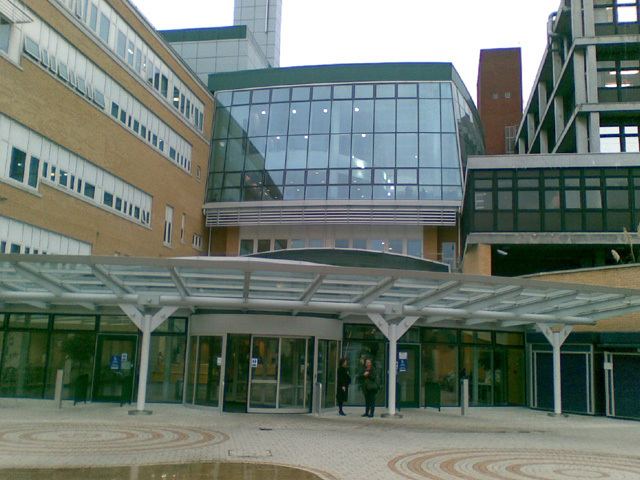Care system Public NHS Lists Hospitals in England Number of beds 360 | Hospital type Acute hospital trust Phone +44 20 7272 3070 Founded 1848 | |
 | ||
Emergency department Yes Accident & Emergency Address Magdala Ave, London N19 5NF, UK Similar Royal Free Hospital, University College London H, The Wellington Hospital, Great Ormond Street Ho, St Thomas' Hospital Profiles | ||
Whittington hospital maternity wing thames news
The Whittington Hospital is a district general and teaching hospital of UCL Medical School and Middlesex University School of Health and Social Sciences. It is named after Sir Richard Whittington and managed by The Whittington Hospital NHS Trust, operating as Whittington Health, an integrated care organisation providing hospital and community health services in the north London boroughs of Islington and Haringey.
Contents
- Whittington hospital maternity wing thames news
- Nhs whittington hospital
- History
- St Marys Wing
- Highgate Wing
- Archway Wing
- City of London Maternity Unit
- References
Following an inspection in December 2015 of the Trust and its services, Whittington Health was rated as Good by the Care Quality Commission in July 2016 - with caring rated as Outstanding The Trust has a current deficit of £5.9m for the year ending 2016/17 - £200k worse than its planned position.
Nhs whittington hospital
History
Although medical services have been delivered on the site since the foundation of a leper colony in 1473, the current hospital has its origins in the Small Pox and Vaccination Hospital, built in 1848. In 1900, a workhouse opened on the grounds of the smallpox hospital and it became a nurses' home. Independently managed hospitals were founded on the Archway site in 1877 and the Highgate site in 1866. In 1946, all three hospitals were brought together under the control of the newly formed North West Metropolitan Regional Hospital Board, Archway Group Hospital Management Committee, jointly forming the Whittington Hospital in 1948. The current hospital on the central St. Mary's site has 360 beds.
St. Mary’s Wing
The Small Pox and Vaccination Hospital was designed by the architect Samuel Daukes as one of two isolation hospitals in London (the other was the London Fever Hospital in Liverpool Road) intended to care for smallpox patients during the epidemic at that time. It closed in 1896 and was officially re-opened as a workhouse infirmary in 1900 by TRH the Duke and Duchess of York.
The past 50 years have seen the consolidation of all clinical services onto the St. Mary’s wing on Highgate Hill. In 1977, a new block opened containing Accident and Emergency, followed by the Great Northern Building in 1992. In 2006, work was completed on the construction of a new clinical block and main entrance on Magdala Avenue. The former smallpox hospital, now known as the Jenner Building, is currently in use as office accommodation.
Highgate Wing
Florence Nightingale advised the architects on the design of the St. Pancras Infirmary building and later commented that it was “by far the best of any workhouse infirmary we have” and indeed “the finest metropolitan hospital”. Edith Cavell was employed at the hospital as night superintendent for three years.
Latterly a psychiatric hospital, in 2004, the Highgate wing on Dartmouth Park Hill was chosen by Camden and Islington Community NHS Trust as the site for Highgate Mental Health Centre and the consolidation and development of community mental health and adult social care services.
Archway Wing
Holborn Union Infirmary was designed by the architect Henry Saxon Snell, who was responsible for a number of other workhouse infirmaries in the capital. In 1928, the hospital took over the Prudential Assurance Company's Furnival House hostel for domestic servants in Cholmeley Park for use as a nurses' home.
In 1998, the Archway wing on Archway Road was jointly purchased by University College London and Middlesex University to form the Archway campus. The teaching and research facility closed in 2013 and the site was sold to the Peabody Trust for redevelopment.
City of London Maternity Unit
In 1750, the Governors for erecting a Lying-in Hospital for married women in the City of London and parts adjacent and also for Out-patients in Phisic and Surgery founded the City of London Lying-in Hospital for married women and sick and lame Outpatients at London House in Aldersgate Street. In 1751, the hospital moved to Thanet or Shaftesbury House also in Aldersgate Street and the second part of the title was dropped following a decision by the General Court of Governors to admit no more outpatients.
In 1773, the hospital moved to purpose built premises designed by Robert Mylne between St. Luke's Hospital for Lunatics and the Fox and Goose Ale House on City Road. Damaged by the construction of the Great Northern and City Railway underneath Old Street, the building was demolished and rebuilt on the same site between 1904 and 1907. The rules were relaxed in 1912, to allow "Singlewomen who are sufficiently recommended and are found to be deserving of the Benefits of the Hospital's Charity" to be eligible for admission for their first confinement and the name was changed to the City of London Maternity Hospital in 1918.
The hospital was granted a royal charter in 1935 and came under the control of the Northern Group Hospital Management Committee in 1948. Damaged by bombing in 1940 and 1941, it was decided not to rebuild on the noisy City Road site at the end of the war and former homes for the blind in Hanley Road were acquired from the Royal National Institute for the Blind in 1949. Clinics continued to be held at City Road until 1955, when a modern building was opened at Hanley Road. In 1983, the hospital was closed and amalgamated with the Whittington Hospital Obstetric Unit to form the present City of London Maternity Unit.
